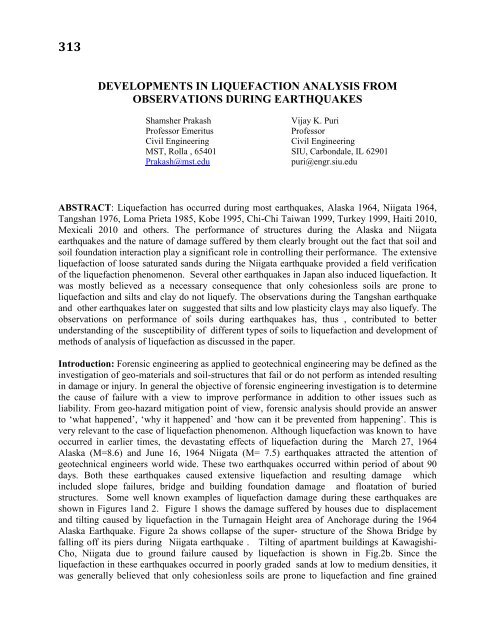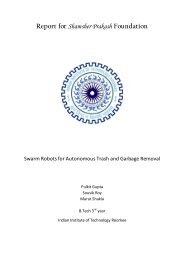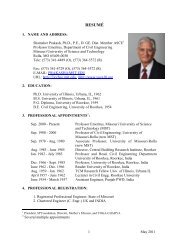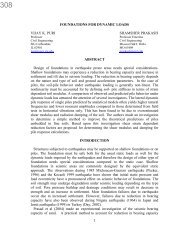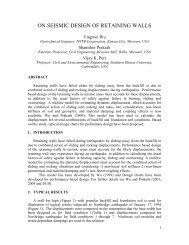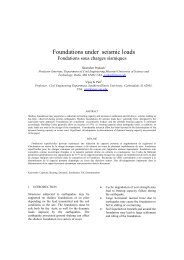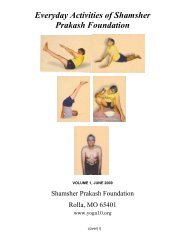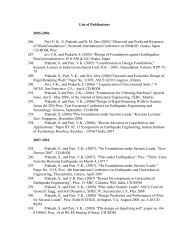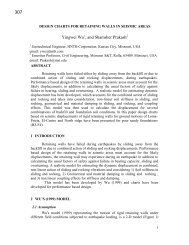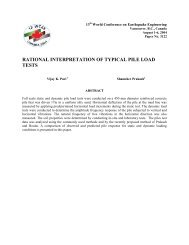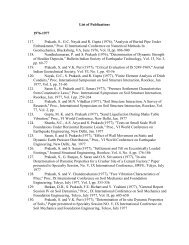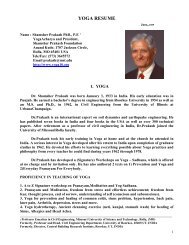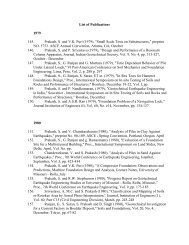developments in liquefaction analysis from observations during ...
developments in liquefaction analysis from observations during ...
developments in liquefaction analysis from observations during ...
You also want an ePaper? Increase the reach of your titles
YUMPU automatically turns print PDFs into web optimized ePapers that Google loves.
313<br />
DEVELOPMENTS IN LIQUEFACTION ANALYSIS FROM<br />
OBSERVATIONS DURING EARTHQUAKES<br />
Shamsher Prakash<br />
Vijay K. Puri<br />
Professor Emeritus<br />
Professor<br />
Civil Eng<strong>in</strong>eer<strong>in</strong>g<br />
Civil Eng<strong>in</strong>eer<strong>in</strong>g<br />
MST, Rolla , 65401 SIU, Carbondale, IL 62901<br />
Prakash@mst.edu<br />
puri@engr.siu.edu<br />
ABSTRACT: Liquefaction has occurred dur<strong>in</strong>g most earthquakes, Alaska 1964, Niigata 1964,<br />
Tangshan 1976, Loma Prieta 1985, Kobe 1995, Chi-Chi Taiwan 1999, Turkey 1999, Haiti 2010,<br />
Mexicali 2010 and others. The performance of structures dur<strong>in</strong>g the Alaska and Niigata<br />
earthquakes and the nature of damage suffered by them clearly brought out the fact that soil and<br />
soil foundation <strong>in</strong>teraction play a significant role <strong>in</strong> controll<strong>in</strong>g their performance. The extensive<br />
<strong>liquefaction</strong> of loose saturated sands dur<strong>in</strong>g the Niigata earthquake provided a field verification<br />
of the <strong>liquefaction</strong> phenomenon. Several other earthquakes <strong>in</strong> Japan also <strong>in</strong>duced <strong>liquefaction</strong>. It<br />
was mostly believed as a necessary consequence that only cohesionless soils are prone to<br />
<strong>liquefaction</strong> and silts and clay do not liquefy. The <strong>observations</strong> dur<strong>in</strong>g the Tangshan earthquake<br />
and other earthquakes later on suggested that silts and low plasticity clays may also liquefy. The<br />
<strong>observations</strong> on performance of soils dur<strong>in</strong>g earthquakes has, thus , contributed to better<br />
understand<strong>in</strong>g of the susceptibility of different types of soils to <strong>liquefaction</strong> and development of<br />
methods of <strong>analysis</strong> of <strong>liquefaction</strong> as discussed <strong>in</strong> the paper.<br />
Introduction: Forensic eng<strong>in</strong>eer<strong>in</strong>g as applied to geotechnical eng<strong>in</strong>eer<strong>in</strong>g may be def<strong>in</strong>ed as the<br />
<strong>in</strong>vestigation of geo-materials and soil-structures that fail or do not perform as <strong>in</strong>tended result<strong>in</strong>g<br />
<strong>in</strong> damage or <strong>in</strong>jury. In general the objective of forensic eng<strong>in</strong>eer<strong>in</strong>g <strong>in</strong>vestigation is to determ<strong>in</strong>e<br />
the cause of failure with a view to improve performance <strong>in</strong> addition to other issues such as<br />
liability. From geo-hazard mitigation po<strong>in</strong>t of view, forensic <strong>analysis</strong> should provide an answer<br />
to ‘what happened’, ‘why it happened’ and ‘how can it be prevented <strong>from</strong> happen<strong>in</strong>g’. This is<br />
very relevant to the case of <strong>liquefaction</strong> phenomenon. Although <strong>liquefaction</strong> was known to have<br />
occurred <strong>in</strong> earlier times, the devastat<strong>in</strong>g effects of <strong>liquefaction</strong> dur<strong>in</strong>g the March 27, 1964<br />
Alaska (M=8.6) and June 16, 1964 Niigata (M= 7.5) earthquakes attracted the attention of<br />
geotechnical eng<strong>in</strong>eers world wide. These two earthquakes occurred with<strong>in</strong> period of about 90<br />
days. Both these earthquakes caused extensive <strong>liquefaction</strong> and result<strong>in</strong>g damage which<br />
<strong>in</strong>cluded slope failures, bridge and build<strong>in</strong>g foundation damage and floatation of buried<br />
structures. Some well known examples of <strong>liquefaction</strong> damage dur<strong>in</strong>g these earthquakes are<br />
shown <strong>in</strong> Figures 1and 2. Figure 1 shows the damage suffered by houses due to displacement<br />
and tilt<strong>in</strong>g caused by <strong>liquefaction</strong> <strong>in</strong> the Turnaga<strong>in</strong> Height area of Anchorage dur<strong>in</strong>g the 1964<br />
Alaska Earthquake. Figure 2a shows collapse of the super- structure of the Showa Bridge by<br />
fall<strong>in</strong>g off its piers dur<strong>in</strong>g Niigata earthquake . Tilt<strong>in</strong>g of apartment build<strong>in</strong>gs at Kawagishi-<br />
Cho, Niigata due to ground failure caused by <strong>liquefaction</strong> is shown <strong>in</strong> Fig.2b. S<strong>in</strong>ce the<br />
<strong>liquefaction</strong> <strong>in</strong> these earthquakes occurred <strong>in</strong> poorly graded sands at low to medium densities, it<br />
was generally believed that only cohesionless soils are prone to <strong>liquefaction</strong> and f<strong>in</strong>e gra<strong>in</strong>ed
313<br />
soils do not liquefy. The Tangshan earthquake, July 28,1976 (M=7.5) provided evidence of<br />
<strong>liquefaction</strong> <strong>in</strong> low plasticity silts and several years later <strong>in</strong> the mid–eighties <strong>liquefaction</strong> aspects<br />
of silty soils were <strong>in</strong>vestigated. Later on , it has been recognized that all soils and <strong>in</strong>clud<strong>in</strong>g low<br />
plasticity clays may be considered liquefiable unless <strong>in</strong>vestigations prove otherwise.<br />
Liquefaction of clayey deposits was observed <strong>in</strong> some earthquakes <strong>in</strong> Taiwan and Iran.<br />
It is , thus seen, that <strong>developments</strong> <strong>in</strong> <strong>liquefaction</strong> <strong>analysis</strong> have been strongly <strong>in</strong>fluenced by the<br />
evidence on their performance dur<strong>in</strong>g the significant earthquakes. The paper discusses the<br />
<strong>developments</strong> <strong>in</strong> <strong>in</strong>vestigation of <strong>liquefaction</strong> <strong>analysis</strong> of sands and f<strong>in</strong>e gra<strong>in</strong>ed soils as they<br />
developed follow<strong>in</strong>g several devastat<strong>in</strong>g earthquakes. If the <strong>liquefaction</strong> susceptibility of a soil<br />
can be ascerta<strong>in</strong>ed before hand and it is found to be prone to <strong>liquefaction</strong> for the design<br />
earthquake, then measures can <strong>in</strong>corporated to mitigate the hazard.<br />
LIQUEFACTION INVESTIGATIONS: The research on <strong>liquefaction</strong> follow<strong>in</strong>g the damage<br />
caused by the Alaska(1964) and the Niigata (1964) earthquakes was devoted to sands and<br />
<strong>in</strong>cluded the follow<strong>in</strong>g;<br />
(a)Investigation of sites damaged by earthquakes<br />
(b) Laboratory tests us<strong>in</strong>g undar<strong>in</strong>ed cyclic triaxial and cyclic simple shear devices.<br />
(c) Vibration or shake table tests<br />
(d) Field tests such Standard Penetration tests (SPT) and Cone Penetration tests (CPT) and<br />
Shear Wave Velocity test.<br />
(e) Numerical <strong>analysis</strong>.<br />
STUDIES ON LIQUEFACTION OF SANDS: The laboratory studies helped identify the<br />
factors govern<strong>in</strong>g <strong>liquefaction</strong> of soils. Seed and Lee (1966) reported the first comprehensive<br />
data on <strong>liquefaction</strong> of sand us<strong>in</strong>g the cyclic triaxial test. Peacock and Seed (1968) used<br />
oscillatory shear device to study <strong>liquefaction</strong> <strong>in</strong> sand and a comparison was made of the shear<br />
stresses caus<strong>in</strong>g <strong>liquefaction</strong> <strong>in</strong> sand <strong>in</strong> the cyclic triaxial and the cyclic simple shear tests. It was<br />
observed that cyclic stresses caus<strong>in</strong>g <strong>liquefaction</strong> <strong>in</strong> loose saturated sands under cyclic simple<br />
shear conditions were only about 35 % of the cyclic stresses required to cause <strong>liquefaction</strong> under<br />
cyclic triaxial conditions. S<strong>in</strong>ce field conditions are more realistically reproduced <strong>in</strong> cyclic<br />
simple shear tests but the cyclic triaxial tests are relatively easier to perform, therefore correction<br />
factors were proposed to correlate the cyclic triaxial data with the cyclic simple shear data. This<br />
resulted <strong>in</strong> the well known ‘simplified procedures’ for <strong>liquefaction</strong> <strong>analysis</strong> of sand deposits. The<br />
sample size used <strong>in</strong> the cyclic triaxial and cyclic simple shear device be<strong>in</strong>g small, it was po<strong>in</strong>ted<br />
out by F<strong>in</strong>n (1972) that test<strong>in</strong>g large samples us<strong>in</strong>g shake table may better represent the<br />
<strong>liquefaction</strong> of field deposits. The results of the shake table studies were showed a general<br />
qualitative agreement with data obta<strong>in</strong>ed <strong>from</strong> cyclic triaxial and cyclic simple shear tests.<br />
Limited studies on <strong>liquefaction</strong> of undisturbed samples of sand were also attempted and it was<br />
observed that natural undisturbed samples were somewhat more resistant to <strong>liquefaction</strong>
313<br />
compared to laboratory made samples at the same relative density due to ag<strong>in</strong>g effects and<br />
strength <strong>in</strong>crease <strong>in</strong> sand due to development of bond between sand particles. Because of<br />
difficulty <strong>in</strong> procur<strong>in</strong>g undisturbed sand samples and the associated cost of perform<strong>in</strong>g such tests,<br />
they cannot be rout<strong>in</strong>ely used for <strong>liquefaction</strong> <strong>analysis</strong>. The same argument applies to shake table<br />
tests. This lead to the search for a field test which could be used for ascerta<strong>in</strong><strong>in</strong>g <strong>liquefaction</strong><br />
susceptibility at a site. The standard penetration test which is rout<strong>in</strong>ely used for sub-soil<br />
exploration showed promise for estimat<strong>in</strong>g the <strong>liquefaction</strong> also. Standard penetration data was<br />
collected for sites which had experienced major earthquakes and where <strong>liquefaction</strong> had or had<br />
not occurred (Seed et al, 1985). The SPT value (N 1 ) 60 has been adopted by the profession as an<br />
<strong>in</strong>dex for <strong>liquefaction</strong> of saturated sand deposits. The plot <strong>in</strong> Fig. 3 (Seed et al.; 1985) has been<br />
commonly used for this purpose. The plot (Fig. 3) with f<strong>in</strong>es content of less than 5% is typical<br />
for the case of sands. The relationship between the cyclic stress ratios and (N 1 ) 60 <strong>in</strong> Fig. 3 is for<br />
an earthquake of magnitude 7.5. For an earthquake of magnitude different <strong>from</strong> 7.5, the cyclic<br />
stress ratio obta<strong>in</strong>ed <strong>from</strong> Fig. 3, should be modified by multiply<strong>in</strong>g with the magnitude scal<strong>in</strong>g<br />
factor (MSF) proposed by Seed et.al; (1975). Also, Liquefaction potential is seen to decrease<br />
with an <strong>in</strong>crease <strong>in</strong> the f<strong>in</strong>e content <strong>in</strong> sand (Fig.3). Seed (1987) suggested the use of effective<br />
SPT value to account for the effect of f<strong>in</strong>es <strong>in</strong> sand. The effective SPT value modifies the<br />
observed penetration resistance to equivalent clean sand penetration resistance and may be<br />
obta<strong>in</strong>ed as follows:<br />
In which <br />
<br />
1<br />
N 1<br />
60eff<br />
N<br />
1<br />
60<br />
N<br />
1<br />
60<br />
(1)<br />
N 60 = observed SPT value, N 60eff<br />
equivalent clean sand penetration resistance and N 1<br />
60 = Correction for silt content.<br />
1<br />
= Effective standard penetration resistance or<br />
The tip resistance <strong>from</strong> cone penetration tests (CPT) can also be used as a criteria for<br />
<strong>liquefaction</strong> (Fig. 4) (Mitchell and Tseng (1990)). CPT has the advantage over SPT <strong>in</strong> its ability<br />
to detect th<strong>in</strong> seams of loose soil.<br />
Shear wave velocity has been as an useful <strong>in</strong>dicator for <strong>liquefaction</strong> . Stokoe et al. (1988) have<br />
used the cyclic stra<strong>in</strong> approach and equivalent l<strong>in</strong>ear ground response <strong>analysis</strong> to <strong>in</strong>vestigate the<br />
relationship between peak ground acceleration for stiff soil site and shear wave ve Shear<br />
velocity has also been recognized as a useful <strong>in</strong>dicator for <strong>liquefaction</strong>. Stokeo et., al. locity and<br />
correlated the data with conditions under which <strong>liquefaction</strong> may or may not develop.<br />
Tokimatsu et. al. (1991) used laboratory tests to develop plots correlat<strong>in</strong>g the cyclic stress ratios<br />
required to produce cyclic stra<strong>in</strong> amplitude of 2.5 % <strong>in</strong> given number of cycles as a function of<br />
shear wave velocity. A typical co-relation is shown <strong>in</strong> Fig.5.<br />
Another approach known as the ‘cyclic stra<strong>in</strong> approach’ has also been proposed to determ<strong>in</strong>e the<br />
susceptibility of <strong>liquefaction</strong> by estimat<strong>in</strong>g the shear stra<strong>in</strong> <strong>in</strong>duced <strong>in</strong> the soil due to seismic
313<br />
load<strong>in</strong>g and compar<strong>in</strong>g it with the threshold stra<strong>in</strong> required to develop <strong>liquefaction</strong>. The typical<br />
value the threshold stra<strong>in</strong> is about 0.01 % (Dobry et al.; 1982) .<br />
GEOHAZARD SIGNIFICANCE OF PROGRESS ON LIQUEFACTION ANALYSIS OF<br />
SANDS<br />
Remarkable progress has been made <strong>in</strong> the ability to estimate <strong>liquefaction</strong> potential of a site<br />
hav<strong>in</strong>g sand deposits by us<strong>in</strong>g laboratory <strong>in</strong>vestigations or on simple <strong>in</strong>-situ tests such as<br />
standard penetration values ( N 1 or (N 1 ) 60 ) or on cone penetration data, and the experience<br />
dur<strong>in</strong>g the past earthquakes. If such site is found prone to <strong>liquefaction</strong>, remedial measures can be<br />
taken at the design stage result<strong>in</strong>g <strong>in</strong> mitigation of the geohazard.<br />
STUDIES ON LIQUEFACTION OF FINE GRAINED SOILS<br />
F<strong>in</strong>e soils such as silts, clayey silts and sands with f<strong>in</strong>es and silty soils were generally considered<br />
non-liquefiable till the early eighties. This concept, however, changed after <strong>observations</strong><br />
follow<strong>in</strong>g the Haicheng (1975) and Tangshan (1976) earthquakes. The soils that liquefied dur<strong>in</strong>g<br />
Tangshan earthquake had clay fraction less than 20%, liquid limit between 21-35%, plasticity<br />
<strong>in</strong>dex between 4% and 14% and water content more than 90% of their liquid limit. Kishida<br />
(1969) reported <strong>liquefaction</strong> of soils with upto 70% f<strong>in</strong>es and 10% clay fraction dur<strong>in</strong>g M<strong>in</strong>o-<br />
Owar, Tohankai and Fukui earthquakes. Tohno and Yasuda (1981) reported that soils with f<strong>in</strong>es<br />
up to 90% and clay content of 18 % exhibited <strong>liquefaction</strong> dur<strong>in</strong>g Tokachi –Oki earthquake of<br />
1968. Soils with up to 48 % f<strong>in</strong>es and 18 % clay content were found to have liquefied dur<strong>in</strong>g the<br />
Hokkaido Nansai –Oki earthquake of 1993. Gold m<strong>in</strong>e tail<strong>in</strong>gs liquefied dur<strong>in</strong>g the Oshima-<br />
K<strong>in</strong>kai earthquake <strong>in</strong> Japan (Ishihara, 1984). These tail<strong>in</strong>gs had silt sized particles and liquid<br />
limit of 31%, plasticity <strong>in</strong>dex of 10 % and water content of 37 %.<br />
Seed et al (1983) suggested that some soils with f<strong>in</strong>es may be susceptible to <strong>liquefaction</strong>.<br />
Such soils (based on Ch<strong>in</strong>ese criteria) appear to have the follow<strong>in</strong>g characteristics:<br />
Percent f<strong>in</strong>er than 0.005 mm (5 microns) ‹15%<br />
Liquid limit ‹ 35 %<br />
Water content › 90<br />
The authors conducted studies on <strong>liquefaction</strong> of low plasticity silts us<strong>in</strong>g naturally occurr<strong>in</strong>g<br />
and laboratory prepared soils and conduct<strong>in</strong>g dynamic triaxial tests. Most significant results of<br />
these studies were that the nature of f<strong>in</strong>es rather than their percentage has a rather significant<br />
<strong>in</strong>fluence <strong>in</strong> determ<strong>in</strong><strong>in</strong>g the susceptibility of silts to <strong>liquefaction</strong> (Puri). The effect of nature<br />
f<strong>in</strong>es can be best def<strong>in</strong>ed <strong>in</strong> terms of plasticity <strong>in</strong>dex of the f<strong>in</strong>e gra<strong>in</strong>ed soil. It was observed that<br />
the cyclic stress ratio caus<strong>in</strong>g <strong>liquefaction</strong> <strong>in</strong> a given number of cycles <strong>in</strong>creases with the
313<br />
<strong>in</strong>crease <strong>in</strong> plasticity <strong>in</strong>dex. It was observed dur<strong>in</strong>g the test<strong>in</strong>g phase that cyclic load<strong>in</strong>g of<br />
plastic silts results <strong>in</strong> pore pressure build up which becomes equal to the <strong>in</strong>itial effective<br />
conf<strong>in</strong><strong>in</strong>g pressure result<strong>in</strong>g <strong>in</strong> development of the <strong>in</strong>itial <strong>liquefaction</strong> for PI < 10.<br />
OTHER RESEARCH ON EFFECT OF FINES ON LIQEFACTION<br />
There are several research f<strong>in</strong>d<strong>in</strong>gs worth mention<strong>in</strong>g on the effect of f<strong>in</strong>es on <strong>liquefaction</strong><br />
potential of soils with f<strong>in</strong>es some of which appear to be somewhat conflict<strong>in</strong>g.<br />
1. Seed et al. (1985) have recommended that for sands conta<strong>in</strong><strong>in</strong>g less than 5% f<strong>in</strong>es, the effect<br />
of f<strong>in</strong>es may be neglected. For sands conta<strong>in</strong><strong>in</strong>g more than 5% f<strong>in</strong>es, the <strong>liquefaction</strong><br />
potential decreases as shown <strong>in</strong> Fig. 3. Neglect<strong>in</strong>g the effect of f<strong>in</strong>es should therefore be<br />
expected to lead to conservative estimates of <strong>liquefaction</strong> potential. However this suggestion<br />
is not based on experimental or field data.<br />
2. Ishihara and Koseki (1989) had suggested that low plasticity f<strong>in</strong>es (PI‹ 4) do not <strong>in</strong>fluence<br />
the <strong>liquefaction</strong> potential. However, they did not consider the effect of the void ratio <strong>in</strong> their<br />
<strong>analysis</strong>.<br />
3. F<strong>in</strong>n (1991) made an observation about the effect of f<strong>in</strong>es <strong>in</strong> sand <strong>in</strong> develop<strong>in</strong>g equivalent<br />
clean sand behavior. If the void ratio of silty sand and clean sand is the same the <strong>liquefaction</strong><br />
resistance decreases. If the comparison is made at the same (N 1 ) 60, the effect of f<strong>in</strong>es is to<br />
<strong>in</strong>crease the <strong>liquefaction</strong> resistance. If comparison is made us<strong>in</strong>g the “the same void ratio <strong>in</strong><br />
and skeleton” as the criteria, then there is no effect on the cyclic strength provided the f<strong>in</strong>es<br />
can be accommodated with<strong>in</strong> the sand voids.<br />
4. Ishihara (1993) mentioned that <strong>in</strong> soils <strong>in</strong> which the f<strong>in</strong>es content is sufficient to separate the<br />
coarser particles, the nature of the f<strong>in</strong>es controls the behavior. Low plasticity or non-plastic<br />
silts and silty sands may be highly susceptible to <strong>liquefaction</strong>. This will be the case when PI<br />
is less than about 10. For soils with moderately plastic f<strong>in</strong>es ( f<strong>in</strong>es content more than about<br />
15 % and 8≤ PI ≤ 15 ), the <strong>liquefaction</strong> behavior may be uncerta<strong>in</strong> and may need further<br />
<strong>in</strong>vestigation. It is obvious that it is still not possible to evaluate the likelihood of <strong>liquefaction</strong><br />
of silts or silty clays with the same confidence as for clean sands without additional<br />
<strong>in</strong>vestigations.<br />
5. Seed et al., (2001) observed that there is significant controversy and confusion regard<strong>in</strong>g the<br />
<strong>liquefaction</strong> potential of silty soils (and silty /clayey soils), and also coarser, gravelly soils<br />
and rockfills.<br />
6. Andrews and Mart<strong>in</strong> (2000) have provided general criteria about <strong>liquefaction</strong> susceptibility<br />
of soils with f<strong>in</strong>es which use clay content and liquid limit of soil.
313<br />
7..Bray et al. (2004) and Boulanger and Idriss (2005) and Idriss and Boulanger (2008) have<br />
suggested for soils with more than 50 % f<strong>in</strong>es clay like behavior should be expected for silts (ML<br />
and MH) that have PI ≥ 7 and for clays (CL and CH). Sand like behavior should be expected if<br />
their PI is < 7.<br />
8. Bray et al. (2004) and Plito (2001) have suggested that the plasticity <strong>in</strong>dex rather than percent<br />
of clay size particles as a criterion for assess<strong>in</strong>g the susceptibility of f<strong>in</strong>e gra<strong>in</strong>ed soils to<br />
<strong>liquefaction</strong>. Bray et al. (2004) found that soils that were observed to have liquefied <strong>in</strong><br />
Aadapazari dur<strong>in</strong>g the Koceli (1999) earthquake did not typically meet the Ch<strong>in</strong>ese criteria for<br />
<strong>liquefaction</strong> susceptible f<strong>in</strong>e gra<strong>in</strong>ed soils. Dur<strong>in</strong>g their <strong>in</strong>vestigation they found that soils with<br />
PI < 12 underwent <strong>liquefaction</strong>, soils between 12 and 18 were moderately prone to <strong>liquefaction</strong><br />
and soils with PI > 18 were not prone to <strong>liquefaction</strong> at the effective conf<strong>in</strong><strong>in</strong>g pressures used <strong>in</strong><br />
the experiments.<br />
9.Wang, Yuan and LI (2007) <strong>in</strong>vestigated the <strong>liquefaction</strong> susceptibility of saturated loess (silty<br />
soil) and f<strong>in</strong>e sand obta<strong>in</strong>ed <strong>from</strong> an airport site near Lanzhou, Ch<strong>in</strong>a. This loess had PI<br />
vary<strong>in</strong>g <strong>from</strong> 7.2 to 9. Their studies <strong>in</strong>dicated that this loess was more susceptible to<br />
<strong>liquefaction</strong> than f<strong>in</strong>e sand.<br />
10.Towhata (2008) has mentioned that it was previously thought that soils with f<strong>in</strong>es are more<br />
resistant to <strong>liquefaction</strong>. However, he has also mentioned that the f<strong>in</strong>es employed <strong>in</strong> those<br />
studies meant silts and clays that were cohesive <strong>in</strong> nature and f<strong>in</strong>e materials without cohesion<br />
may still be vulnerable. It is the op<strong>in</strong>ion of the authors based on the data presented here that<br />
the soils with low plasticity (PI < about 7) may liquefy or develop large deformations under<br />
cyclic load<strong>in</strong>g.<br />
11. Ghalandarzadeh, Ghahremani and Konagai (2007) Investigated <strong>liquefaction</strong> behavior of<br />
clayey sand <strong>from</strong> a site where large sand boil<strong>in</strong>g, soften<strong>in</strong>g and large deformations had been<br />
observed <strong>in</strong> Iran due to an earthquake of magnitude 6.4. The soil had a liquid limit of 38 %,<br />
PI=18 %, and f<strong>in</strong>e fraction (f<strong>in</strong>er than 75 microns) of 44%. They performed cyclic triaxial<br />
tests . The <strong>analysis</strong> of data <strong>in</strong>dicated that the clayey sand deposit likely developed high<br />
residual excess pore water pressures and significant shear stra<strong>in</strong>s dur<strong>in</strong>g the earthquake and<br />
experienced <strong>liquefaction</strong>.<br />
12. Thevanaygam (2010) has observed that at the same void ratio, the cyclic resistance of sand<br />
decreases with an <strong>in</strong>crease <strong>in</strong> silt content upto a certa<strong>in</strong> threshold value of f<strong>in</strong>es content (fc th );<br />
thereafter the cyclic resistance <strong>in</strong>creases with further <strong>in</strong>crease <strong>in</strong> silt content. Silt content affects<br />
the <strong>in</strong>ter-gra<strong>in</strong> contact density of soil compared to that of sand at the same void ratio. When this is<br />
taken <strong>in</strong>to account , sand and silty sand show similar <strong>liquefaction</strong> resistance at same equivalent<br />
void ratio (e c ) eq . Figure 6 shows that at the same equivalent void ratio , the number of cycles<br />
<strong>in</strong>duc<strong>in</strong>g 5 % stra<strong>in</strong> is almost the same for clean sand (OS-00), sand with 15 % silt (OS-15) and<br />
sand with 25 5 silt (OS-25)
313<br />
GEOHAZARD SIGNIFICANCE OF PROGRESS IN LIQUEFACTION OF FINE<br />
GRAINED SOILS<br />
The <strong>liquefaction</strong> of f<strong>in</strong>e gra<strong>in</strong>ed soils has certa<strong>in</strong>ly received the attention of researchers and<br />
progress is be<strong>in</strong>g made <strong>in</strong> this direction <strong>in</strong> the last 30 years. Presently (2010) there is no well<br />
def<strong>in</strong>ed <strong>in</strong>dex to ascerta<strong>in</strong> the <strong>liquefaction</strong> potential of f<strong>in</strong>e gra<strong>in</strong>ed soils like SPT or CPT <strong>in</strong> case<br />
of sands. From geo-hazard mitigation po<strong>in</strong>t of view lot more needs to be done , a site <strong>in</strong> seismic<br />
zone where silts and clays with low plasticity (PI < about 7-10) careful <strong>in</strong>vestigations should done<br />
to ascerta<strong>in</strong> the likely hood of <strong>liquefaction</strong>.<br />
CONCLUSIONS<br />
Progress <strong>in</strong> <strong>liquefaction</strong> research and procedures of <strong>analysis</strong> has been strongly <strong>in</strong>fluenced by the<br />
<strong>observations</strong> on <strong>liquefaction</strong> related damage follow<strong>in</strong>g the major earthquakes. These<br />
<strong>observations</strong> also provided a field verification of this hazardous phenomenon of <strong>liquefaction</strong>.<br />
Most of the efforts was devoted to <strong>liquefaction</strong> of sands s<strong>in</strong>ce major earthquakes occurred <strong>in</strong><br />
alluvial deposits. When evidence became available about <strong>liquefaction</strong> of f<strong>in</strong>e plastic soils <strong>in</strong><br />
(1976) research to determ<strong>in</strong>e <strong>liquefaction</strong> susceptibility of f<strong>in</strong>e gra<strong>in</strong>ed soils started <strong>in</strong> early<br />
eighties. There are many conflicts still there about <strong>liquefaction</strong> of f<strong>in</strong>e gra<strong>in</strong>ed soils. For<br />
mitigat<strong>in</strong>g <strong>liquefaction</strong> related geo-hazard dur<strong>in</strong>g future earthquakes it is of utmost importance<br />
that a geotechnical eng<strong>in</strong>eer should be able ascerta<strong>in</strong> the proneness to a site for <strong>liquefaction</strong> , be<br />
it sands, silts or clays of low plasticity.


